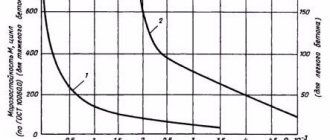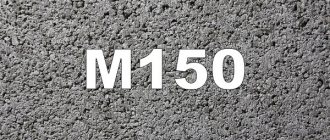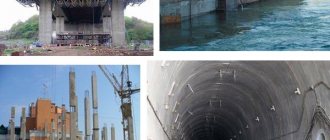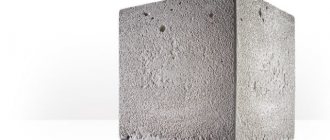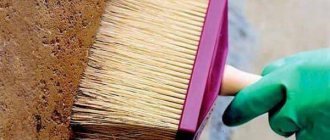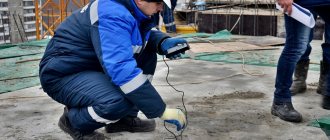Concrete is used everywhere in construction. However, it must be taken into account that its different types differ significantly in quality and strength. To choose the material that is best suited for a particular situation, let’s understand what grades of concrete and its classes are, and how its varieties differ from each other.
The strength of concrete must comply with standards Source i.ytimg.com
What is concrete?
By mixing cement, crushed stone or gravel and sand in certain proportions, the desired composition is obtained. With water, cement forms a sticky milk; the liquid fills the pores between the fillers and hardens, binding them into an inextricable whole.
The chemical process of crystalline hydrate formation ensures a loss of fluidity within several hours, rapid hardening, and a gradual increase in strength. Achievement of standard indicators of artificial stone occurs 28 days after pouring, but the process continues, the monolith gains strength over the years.
This is how concreting occurs in the temperature range +(5-25) 0. In winter, the technology is more complicated; water in a liquid composition should not turn into ice.
Waterproof
The W index determines how well the solution does not allow moisture to pass through itself under pressure. The numerical value of water resistance varies from 2 to 20. If builders use concrete in 15 f150 w6, this means that its hydrophobicity is below average. To increase water resistance in the manufacture of building materials, various sealing additives are used.
Water resistance is not particularly important when using the mixture in civil engineering. It’s another matter if the solution is used in the construction of breakwaters, bridge supports and other structures in contact with water. In such a situation, moisture-resistant concrete is required, which means its performance is higher than W10.
Factors affecting the quality of concrete
All components included in the construction mixture have a certain influence on its properties and determine the place of application.
Product labeling
The type of cement according to GOST 31108-2003 determines the composition. In the new marking, the strength is “B”, instead of “M”. The location of its application depends on the type of cement.
- Portland cement CEM I, pure, without additives;
- CEM II – clinker cement with mineral additives;
- Portland slag cement CEM III;
- Pozzolanic – CEM IV;
- Composite – CEM V.
If previously the product data sheet contained a brand of cement (average indicator), now its equivalent is maximum strength. Manufacturers simultaneously label their product according to GOST 10178-85, which is more familiar to users, indicating M300-M600 and the presence of additives D.
Classification by fillers
Based on the nature and structure of concrete mass aggregates, a classification table by density kg/m3 is presented
| Name | Density | View | Purpose |
| Extra heavy | >2500 | Barite, magnetite, with cast iron shot | For buildings with radiation protection |
| Heavy | 2200-2500 | With fine aggregate, quickly hardens, high strength, on fine sand | Factory, high-rise, hydraulic, ceilings. |
| Lightweight | 1800-2200 | Lightweight fillers, cellular | Fencing, unloaded structures |
| Easy | 500-1800 | Tuff, perlite. vermiculite | Walling |
| Particularly light | <500 | Foam concrete, aerated concrete | Insulation |
Classification by structure
There are dense, large-porous, cellular concretes. The higher the density of the material, the stronger the material.
Dense concrete mixtures are used for the manufacture of load-bearing structural elements. According to technical standards, the volume of air pores should not exceed a threshold of 6%. By introducing additives that involve air, porous concrete is obtained (air content no more than 12%). This structure reduces thermal conductivity and prevents delamination of the material.
Large-porous concrete mixtures are made without adding sand. Gravel fillers of different fractions are used as filler. The material is used for structures with low stress.
Cellular foam concrete and aerated concrete are made using additives that form pores inside the material. They have high thermal insulation properties. Used in low-rise construction. Or as a wall material for non-load-bearing structures for multi-storey buildings.
Performance characteristics
Water permeability and frost resistance of a concrete monolith are interrelated characteristics. The less water gets into the concrete, freezes and expands, the more freezing cycles the artificial stone will withstand without destruction from weathering. Water resistance (W) is an indicator of the water pressure on the surface at which water penetrates the pores of concrete. Frost resistance (F) shows how many freezing cycles the sample will withstand before its strength decreases
Workability of concrete
Cement begins to form crystalline hydrates in the concrete mass immediately after mixing with water. You can delay the process by stirring. Delivery in a mixer lengthens the setting time, but the live mass remains no more than 3-4 hours after mixing. The specific time reserve depends on the characteristics - the hardness of the solution, the mobility of the mass. The survivability of the solution and mobility determine the workability of the concrete mixture.
Strength characteristics of concrete
The main characteristic, the compressive strength of concrete, depends on the total factors: the quality of the cement and the components used, maintaining the mixing technology, pouring and caring for the mass until it gains strength.
Samples from each batch of concrete are tested for strength gain under normal conditions (20 0 C). The process of hardening and strength gain is checked on days 3, 7, 14, 28 after pouring. Standard samples are poured into prepared molds when the batch is delivered to the site. 3 samples are crushed under pressure, showing average resistance to destructive force “M” in kgf/cm2.
Frost resistance
The frost resistance parameter allows you to determine how many cycles of thawing and freezing a material can withstand over a certain time while maintaining its original characteristics. For marking, the symbol F and a numerical designation from 25 to 1000 are used. For example, consider what f75 concrete means. This value indicates that the building material is capable of maintaining its properties for up to 75 freeze/thaw cycles.
It is important to understand that sub-zero temperatures promote the expansion of moisture located in the pores of the building material - the larger the volume of these pores, the lower the frost resistance. At low rates, the material reduces the load-bearing capacity of building structures and ensures faster wear of their surface.
By finding out what concrete with one or another marking means, you can correlate its frost resistance with strength indicators. The table suggests the ratio of these parameters for the most common solutions.
| Class | Frost resistance | Brand |
| B12.5 | F50 | M150 |
| B15 | F100 | M200 |
| B20 | F150 | M250 |
| B22.5 | F200 | M200 |
| B25 | F200 | M350 |
| B30 | F200-F300 | M400 |
| B35 | F200-F300 | M450 |
Standardization of indicators
Depending on where the mixture will be used, the concrete is classified into grades and classes, which allows you to order a commercial mixture of the required quality. Specialists have developed technological maps with the compositional composition of mixtures. Concrete is identified by its compressive strength 28 days after pouring the sample and hardening it at a temperature of 20 0 C.
Brand – the average numerical value of the breaking force of standard samples, measured kgf/cm2. In international standards, it is customary to denote the breaking load in MPa. This indicator has the index “B”; it does not indicate the average, but the absolute number of samples corresponding to the parameter. Downward deviations may occur in 5% of samples.
Class, brand, characteristics, application
| MPa class | Brand kgf/cm2 | frost resistance | water permeability | Application of concrete mixture |
| B 7.5 | M100 | F50 | W2 | Foundation in dry soil, poured before concreting the base. |
| AT 10 | M150 | F50 | W2 | Floor screed, arrangement of garden paths |
| B12.5 | M150 | F100 | W2 | Subfloors, low-load foundation |
| B15 | M200 | F100 | W4 | Screed, foundations, blind areas, cesspools, settling tanks |
| IN 20 | M250 | F100 | W4 | Reinforced concrete beams and floor slabs, stairs |
| B22.5 | M300 | F200 | W6 | By dense reinforcement of thin-walled, high-rise buildings |
| B30 | M400 | F300 | W10 | Road and airfield pavement, hydraulic structures. |
The properties of concrete can be improved by using vibrating placement and adding the necessary additives. It can be spoiled by keeping it in the mixer for longer than the allotted time, improper manual kneading, dirty water or sand.
Types of concrete by type of binder
Concrete is classified according to the type of main binder.
Among them are:
- Cement. Based on various grades of cement, the most common and sought-after type of concrete mixtures. They are used for interior and exterior construction work. Popular brands of concrete made on the basis of Portland cement.
- Special. Depending on the purpose, various types of fillers are added to cement mixtures, for example, fine metal shavings for strength. The addition of magnesite increases heat resistance, barite increases the protective properties of the material from the penetration of X-rays and radiation.
- Reinforced concrete. Reinforcement of concrete structures with metal.
- Slag-alkaline. They are made from slag-alkaline cement, which includes crushed slag. When adding alkaline components, a chemical reaction occurs between aluminosilicates and clay components. Its technical characteristics, frost resistance, water resistance, and strength are superior to cement-based concrete. Industrial waste and slag are disposed of. A promising direction for the development of the construction industry.
- Foam concrete. Foamed cement mixture with the addition of sand, water, construction fiber. It has low thermal conductivity and good moisture resistance. There are structural and heat-insulating foam concrete, and they are marked accordingly.
- Aerated concrete. Porous material, produced by autoclaving. Low thermal conductivity, but can absorb moisture.
- Fiber-reinforced concrete. Saturation of the cement mixture with fiber fiber gives it additional strength. This process occurs due to the fastening of all components together by many small fibers.
- Arbolit. Blocks made from cement and wood shavings. Warm material, but absorbs moisture.
- Kevlar concrete. It is made on the basis of marble, boundary chips, polyester resins, liquid glass with the addition of a catalyst. The result is an imitation of natural stone. Or using technology based on cement pellets, using a gravity concrete mixer.
- Polymer-cement. Polymer fillers and resins are added to cement. The concrete mixture acquires additional strength and is highly waterproof.
- Plaster. Used for finishing interior construction work. The addition of plasticizers, fiber, and other components increases strength and moisture resistance.
- Silicate. Made from silica, calcium oxide hydrate. Autoclave high temperature treatment increases strength.
The universal properties of the concrete mixture are that, depending on the composition of the components and additives, materials with a wide range of technical characteristics are obtained.
Ways to increase the strength of concrete
To increase the strength properties of artificial stone, fiber fillers and reinforcing additives from metal rods, basalt, polypropylene and glass fibers are introduced into the concrete mass. They are added to the batch, fractionally, in small portions. The random arrangement of the fiber ensures that loads are absorbed not in the zone of action of classical reinforcement, but evenly.
Advantages of using fiber:
- The mass does not delaminate and has greater plasticity.
- Increases abrasion resistance and bending strength.
- Improves adhesion of adhesive to inert composites.
The technology for introducing additives varies depending on their type. Reinforcing a structure with fiber is cheaper than with mesh.
General information
Concrete is an artificial stone-like building material obtained by hardening a pre-mixed and compacted mixture. Its properties depend on the proportions of the components it contains:
- astringent;
- fillers;
- shutters;
- additives (if necessary).
Here we can conclude that concrete grades and their use are interrelated: there is no point in making the same consistency for the foundation and for the path - this is, first of all, economically unprofitable. Each type of mixture must satisfy the specified technological parameters and meet the required quality indicators after hardening.
Classification of artificial stone is carried out according to the following criteria:
- appointment;
- average density;
- type of binder;
- structure;
- type of aggregates;
- compaction conditions.
Classification of artificial stone by structure :
- large porous;
- porous;
- dense;
- cellular.
The quality indicators of concrete materials are:
- grade for frost resistance, medium density and water resistance;
- class for tensile and compressive strength.
Additives that improve the characteristics of the concrete mass
To improve the performance properties of the concrete mass, chemical additives are used in accordance with GOST 24211-2008. Plasticizers, water-reducing and stabilizing additives will give improved properties to concrete dough.
The properties of cementitious composites change the rate of hardening by chemical accelerators or retarders. This group includes additives that reduce water permeability, increase frost resistance and corrosion resistance of reinforcement.
Anti-frost mixtures and compositions for “cold” and “warm” concrete give special properties to cement-based composites. There are many of them, each composition, in addition to the main effect, can affect frost resistance, strength, and reduce cement consumption. Technologists select the required ingredient, and they also develop the recipe for use.
Pricing and cost of branded concrete
The choice and purchase of a specific class and brand is determined primarily by your project. But, despite the calculations, it is necessary to take into account factors that could have been omitted at the project stage (for example, groundwater leakage), navigate on the spot and select a brand empirically. There is a direct dependence of the price of concrete on its brand, since the latter is determined by the amount of binder in the mixture, the most expensive component. The higher the brand, the higher the price. It is all the more important to choose the optimal material in order to protect yourself from risks and not overpay for inflated strength indicators.
Methods for laying concrete mass that affect the strength of artificial stone
Mixing concrete dough in a concrete mixer or mixer is accompanied by saturation of the mass with air. When laying, the mass is compacted using vibrators. The process is mandatory, since air bubbles formed in the thickness will affect the strength of the structure and contribute to the appearance of cracks. The process is regulated by SNiP 3.03.01-87.
Vibration - mechanical vibrations in the solution destroy the structure of the poured product, its composition is leveled, and liquefaction occurs. The inevitable delamination is removed, air is displaced, the poured solution is compacted, and shrinks less when it hardens.
According to the degree of impact on the mass, they are distinguished:
- superficial;
- deep;
- external vibration activators.
Vibrating platforms and vibrating tables are installed in industries that form slab products. The production of vibrating plates is established at all enterprises that produce molded reinforced concrete products for load-bearing structures. Vibrating tables are used for the production of paving slabs.
At the construction site, vibrator installations are installed outside the foundation formwork. The vibrations are transmitted through the formwork or other form, facilitating the flow of mass from the bucket or bunker.
Surface vibration is performed using special slats of different types on which the vibrator is installed. They are used to form a smooth surface for vibrating plates. Deep method - a vibrating head is lowered deep between the reinforcement in massive structures, columns. If the pour is fractional, the vibrator should mix the layers to a depth of 10 cm.
Proportions of cement, sand and crushed stone to produce concrete of a certain grade
To calculate the ratio of concrete components, the volume of cement is taken as 1 part. The volume of other components is determined according to the information in the table below.
Thus, the proportion per 1 m3 for grade M200 using M400 cement weighing 280 kg, sand 740 kg and crushed stone 1250 kg will take the following form: 1: 2.8: 4.8. A prerequisite for obtaining good cement is a water content of 20% of the total volume (180 l).
Table of proportions for obtaining concrete of a certain grade
| Concrete grade | Cement brand | Ratio of parts by weight, kg | Volume ratio, l | ||||
| Cement | Sand | Crushed stone | Cement | Sand | Crushed stone | ||
| M200 | M 400 | 1 | 2,8 | 4,8 | 10 | 25 | 42 |
| M 500 | 1 | 3,5 | 5,6 | 10 | 32 | 49 | |
| M300 | M 400 | 1 | 1,9 | 3,7 | 10 | 17 | 32 |
| M 500 | 1 | 2,4 | 4,3 | 10 | 22 | 37 | |
| M400 | M 400 | 1 | 1,2 | 2,7 | 10 | 11 | 24 |
| M 500 | 1 | 1,6 | 3,2 | 10 | 14 | 28 | |
| M500 | M 400 | 1 | 1,1 | 2,5 | 10 | 10 | 22 |
| M 500 | 1 | 1,4 | 2,9 | 10 | 12 | 25 | |
Monitoring technical parameters of solid and liquid concrete
The properties of concrete mixtures are standardized by Russian GOST 7473-2010, adapted to the international quality standard EH 206-1:2000. Its area of action covers heavy (BST), fine-grained (BSM) and light-weight (BSL) cement-based concrete. The standard concerns products for the construction of monolithic and prefabricated monolithic objects and the formation of vibrating plates and other load-bearing structures in concrete factories.
Samples are taken at the place where the mixture is laid, at the time of shipment of the batch to the RBU or from the transport tank. Samples are taken from a solid structure in the form of a core, or mold, standardized for analysis. Concrete tests are carried out in accordance with GOST 10181-2000. Two control methods are used - destructive and non-destructive.
Non-destructive testing of solid surfaces
Assessment of the condition of structures is most often carried out to determine whether the concrete strength corresponds to the design strength. When controlling, direct and indirect methods are used.
Direct is based on taking samples by chipping an edge, tearing off a fragment with chipping or tearing off the metal. Local destruction methods are accurate and are used to chart non-destructive ultrasound examinations. The most commonly used method is pulse impact using a Schmidt hammer, elastic rebound, and plastic deformation.
The purpose of the study is to obtain an objective picture without cutting samples and taking core samples.
Destructive testing
Determining the strength index under pressure with the destruction of the sample and measuring the ultimate strength is the most accurate method for determining strength. When at least 3 samples are destroyed, the average strength “M” is determined. The class of concrete is determined by the totality of indicators of several batches.
Selected samples in the shape of a 20x20 cm cube or other standard dimensions are stored at a temperature of 20 0 C. Some of the samples are destroyed during analysis, others are stored for arbitration cases.
In doubtful cases, the manufacturer can select at least 3 samples of a standard format, a cube with 20 cm sides, draw up a report signed by the delivery person and submit them for testing to an independent construction laboratory.
Based on the test results of a batch of concrete, a protocol with a serial number is drawn up and entered into an electronic database. The average strength value and class of concrete are indicated there.
Features of different brands
Each of the brands used is suitable for a certain range of tasks. Below we will consider those that are used most often.
M50-M100
Concrete grade M50 is considered the weakest and most unreliable. However, it has its own scope of application.
Weak concrete cannot be used for structures under tension Source forums.drom.ru
How to make concrete in artisanal conditions
It happens that the blind area is damaged, the garden path begins to crumble, you need to put up a new fence - there is not much concreting, it is not profitable to order a mixer. You can make the solution yourself from a ready-made building mixture in a bag, or assemble the components yourself.
Required:
- Cement, fine powder of gray or greenish color, without lumps.
- Crushed stone, crushed gravel of large and medium size.
- Dry sand washed to remove clay and roots.
- Water at room temperature, clean, not hard.
- Mixer or kneading trough, shovel, bucket.
For better plasticity of the solution, you can use household plasticizers - strong soap solution, PVA glue and liquid glass. They will increase ductility, strength and water-repellent properties.
Component proportions
On the packaging of a bag of Portland cement CEM I, the weight ratio of the parts when mixing M200 is 1: 2.3: 3.4. In volume fractions, taking into account the density of the components, it will be like this:
For 1 volume of cement, take 2 parts sand and 4 crushed stone. Stir and add 0.5 volumes of water in fractions. Less is possible, provided the plasticity of the solution is ensured with additives.
To obtain M250, add another half of the volume of crushed stone to the trough, leaving the remaining components in the same quantity. To mix cement, you need 25% of the amount of water, but such a mixture will be difficult to stir, so fractional addition of water is needed to create the desired consistency.
Application of different grades of concrete
For simple work that does not require special strength, there is no need to use high-grade compounds, as this is not profitable. You should also not save money if the life and health of people depends on the strength and reliability of the structure. Let's consider what brand of concrete is needed for the floor and other most common options for using concrete mixtures.
Concrete grades for strip foundations
Strip foundations are well suited for private construction. A reinforced concrete strip, buried in the soil, goes around the perimeter of the building and passes under the load-bearing elements. The choice of concrete grade for the strip foundation of a private house is determined by the weight of the structure, the type of soil, the presence of groundwater, and the climatic features of the area.
Concrete M100–150 is suitable for pouring the cushion under the base. To build a foundation on stable soil, if the house is one-story, then it is better to buy M200 concrete. Concrete M300 is a universal option for private houses with 1–2 floors. This is a good combination of price and durability.
Concrete grades for floor screed
Concrete M100–200 is suitable for the floor in a residential area. M100 can be used for preparatory work before laying the main foundation, arranging floors in small rooms, and laying heated floors. M200 is a universal option that is strong enough for floors to last for several decades. Concrete M250 and higher grades are used for pouring floors in rooms with high loads.
Concrete grades for blind areas
Blind areas are not subject to heavy loads or mechanical damage, but their strength is affected by flowing water, so when choosing concrete you need to take into account its frost resistance and moisture resistance. M200, 250, 300 have optimal characteristics. In this case, the blind area will well protect the foundation from dampness and the consequences caused by it - the appearance of cracks and voids, subsidence of the foundation.
Concrete grades for garage
To build a foundation on loamy soil, you will need a stronger solution than for sandy loam. If the garage is made of brick or stone blocks, M300 or M400 concrete will do. If you build from metal sheets, foam blocks and cinder blocks, M200 will be enough. For a garage with a basement you need an M350 solution. The general rule is that the heavier the structure and soil, the higher the grade.
When pouring a garage floor, M300 mortar has optimal characteristics, but M350 concrete is also suitable. It will provide high dynamic stability, will not allow water to pass through, crumble or create dust.
Concrete grades for house foundations
The choice of brand depends on the type of base, the presence of a basement or basement, the weight of the overall structure, and the type of soil. M250 is suitable for strip-column structures and pile foundations. Such a foundation can be made in areas with height differences and unstable soil. You can make poured piles yourself. If the soil is loamy, it is better to take M300 or M400. These grades are suitable for constructing strip and bored pile structures with a monolithic grillage.
Requirements for cements for concrete
For most construction work, cement concrete is used, where Portland cement is used as a binding component. There is also limestone, but its scope of application is limited mainly to finishing work, which is done “the old fashioned way.”
Types of Portland cement and their storage
There are several types of Portland cement: Portland slag cement, aluminous cement and pozzolanic cement. They all differ slightly in characteristics, but any are suitable for private construction. The difference can only affect the setting time: slag Portland cement takes the longest to harden - up to 12 hours, followed by standard Portland cement - up to 10 hours, and aluminous binder hardens the fastest - no more than 8 hours.
Cement for concrete must be dry, free-flowing and fresh
Cement is demanding on storage conditions, and especially humidity. For the manufacture of important structures - foundations, floors, etc. It is advisable to use fresh one, recently released from the factory. Within a month it loses up to 10% of its properties, and after 6 months they deteriorate by 30-35%. Therefore, for example, when pouring a foundation, it is better to take it a maximum of two weeks ago and purchase it shortly before use.
Store in a dry, ventilated area. If there is no room, they are stored under a roof or wrapped in several layers of film to protect them from moisture. Please note - wrapped, not covered. And preferably not on the ground, but on a wooden floor. The thing is that when moisture gets in, even in a vapor state, the cement becomes lumpy, which greatly worsens the characteristics of concrete. If there is an abundance of moisture, it simply becomes a stone and there is no way to use it. Therefore, take care of a place to store cement in advance.
Cement marking
What brand of cement should be used is usually indicated in the concrete recipe. It is designated by the letter M and numbers that indicate the maximum concrete strength that can be achieved with this binder. For example, with M400 grade cement you can get maximum concrete grade M400, as well as lower ones.
Next comes the letter “D” and numbers indicating the amount of impurities. M400 D15, means that there are 15% impurities in the binder. For construction work, this figure should not be more than 20%.
